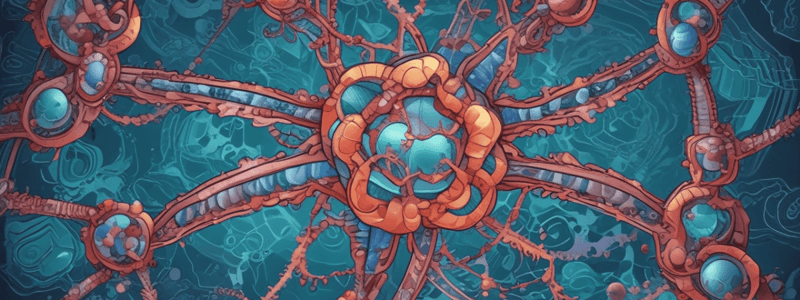Podcast
Questions and Answers
What are nucleosides composed of?
What are nucleosides composed of?
- Sugar and nitrogenous base (correct)
- Nitrogenous base and phosphate group
- Sugar and phosphate group
- Purine and pyrimidine
Which of the following is a pyrimidine base found in RNA?
Which of the following is a pyrimidine base found in RNA?
- Adenine
- Guanine
- Uracil (correct)
- Thymine
What is the difference between DNA and RNA in terms of their pentose sugars?
What is the difference between DNA and RNA in terms of their pentose sugars?
- DNA contains uracil, RNA contains thymine
- DNA contains adenine, RNA contains guanine
- DNA contains ribose, RNA contains deoxyribose
- DNA contains deoxyribose, RNA contains ribose (correct)
What type of bond links the sugar to the nitrogenous base in a nucleoside?
What type of bond links the sugar to the nitrogenous base in a nucleoside?
What is the term for the structure containing a sugar and a nitrogenous base?
What is the term for the structure containing a sugar and a nitrogenous base?
What type of bonds link nucleotides together in nucleic acids?
What type of bonds link nucleotides together in nucleic acids?
What is the general secondary structure of DNA?
What is the general secondary structure of DNA?
What is the polarity of a nucleic acid strand?
What is the polarity of a nucleic acid strand?
What is the primary function of nucleic acids in living cells?
What is the primary function of nucleic acids in living cells?
What are the two types of nucleic acids found in living cells?
What are the two types of nucleic acids found in living cells?
What is the distinctive structure composed of in nucleotides?
What is the distinctive structure composed of in nucleotides?
What is the difference between nucleosides and nucleotides?
What is the difference between nucleosides and nucleotides?
What is the purpose of protamines and histones in nucleoproteins?
What is the purpose of protamines and histones in nucleoproteins?
What is the significance of the 5-carbon sugar in nucleotides?
What is the significance of the 5-carbon sugar in nucleotides?
What is the term for the phosphate group linkage between nucleotides?
What is the term for the phosphate group linkage between nucleotides?
What is the difference between ribose and deoxyribose?
What is the difference between ribose and deoxyribose?
Flashcards are hidden until you start studying
Study Notes
Nitrogenous Bases
- There are two classes of nitrogenous bases: purines and pyrimidines, which are present in RNA and DNA.
- Purine bases: adenine (A) and guanine (G), which contain two rings in their structure.
- Pyrimidine bases: cytosine (C), uracil (U), and thymine (T), with cytosine found in both DNA and RNA, thymine found in DNA, and uracil found in RNA.
Nucleosides
- A nucleoside is a structure containing a sugar and a nitrogen base linked via a covalent N-glycosidic bond.
- The atoms of the base in nucleosides are given cardinal numbers, while the carbon atoms of the sugars are given primed numbers.
Nucleic Acids
- Nucleic acids are polymers of nucleotides joined by 3′, 5′-phosphodiester bonds, with a phosphate group linking the 3′ carbon of a sugar to the 5′ carbon of the next sugar in the chain.
- Each strand has a distinct 5′ end and 3′ end, giving it polarity.
- DNA is generally double-stranded (dsDNA), while RNA is generally single-stranded (ssRNA).
Nucleotides
- Nucleotides are composed of three covalently bound components: a nitrogen-containing base (either a pyrimidine or purine), a 5-carbon sugar (ribose or deoxyribose), and a phosphate group.
- Nucleotides can be broken down into nucleosides (sugar + base) and phosphate groups.
Importance of Nucleic Acids
- Nucleic acids are present in all living cells and transfer genetic information from parents to offspring.
- They are polymers of specific nucleotides, with two main types: deoxyribonucleic acid (DNA) and ribonucleic acid (RNA).
Studying That Suits You
Use AI to generate personalized quizzes and flashcards to suit your learning preferences.




